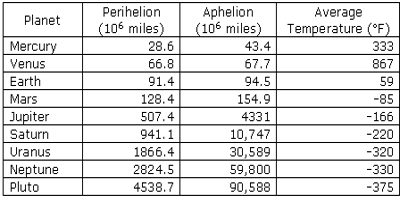The planets do not emit light of their own. They reflect the Sun’s light that falls on them. Only a fraction of the solar radiation is absorbed and it heats up the surface of the planet. Then it radiates energy. We can determine the surface temperature T of the planet using Stefan’s law of radiation E = σ T4 where a is the Stefan’s constant and E is the radiant energy emitted by unit area in unit time.

In general. the temperature of the planets decreases as we go away from the Sun. since the planets receive less and less solar energy according to inverse square law. Hence, the planets farther away from the Sun will be colder than those closer to it. Day temperature of Mercury is maximum (340°C) since it is a planet closest to the Sun and that of Pluto is minimum (-240°C). However Venus is an exception as it has very thick atmosphere of carbon-di-oxide. This acts as a blanket and keeps its surface hot. Thus the temperature of Venus is comparitively large of the order of 480°C.













